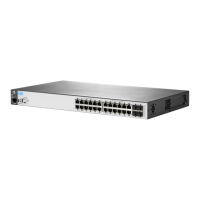1. In the first text box, type J4858 (for 100-Mb and Gigabit information) or J8436 (for 10-Gigabit
information).
2. Select any of the products that display in the drop down list.
3. Select Product support information. Then click on Manuals and find the Transceiver Support
Matrix.
• Third-Party connectivity accessories
Hewlett Packard Enterprise designs and manufactures its products for use with genuine Hewlett
Packard Enterprise connectivity accessories such as transceivers and SFPs. Use of genuine Hewlett
Packard Enterprise products ensures that your network maintains optimal performance and reliability.
Third-party connectivity accessories including any non-genuine products are not supported and their
use may result in product malfunction, or in degraded network performance and reliability. Customers
who choose to purchase, install, or use third-party or non-genuine Hewlett Packard Enterprise
connectivity accessories do so at their own risk.
Hewlett Packard Enterprise, at its discretion, may not provide support for networking problems resulting
from the use of third-party transceivers or SFPs. However, the warranty on genuine Hewlett Packard
Enterprise products is not affected.
Should you require additional Hewlett Packard Enterprise connectivity accessories, please contact
a Hewlett Packard Enterprise sales representative or authorized reseller.
• Hot swapping transceivers. The transceivers that you can install in your Hewlett Packard Enterprise
switch can be “hot swapped” — removed and installed after the switch starts receiving power. You
should disconnect the network cables from the transceivers before hot swapping them.
Best practice tip: After inserting a transceiver into a switch, the Mode LED will be on for two seconds
while the transceiver is initialized. Do not remove the transceiver until the Mode LED has turned off.
When you replace a transceiver with another transceiver of a different type and then execute the
write memory command through the switch console, the switch configures the port on the new
transceiver with the default mode (speed and duplex) settings used for the new transceiver type. The
default mode for the transceivers is Auto. The switch retains other port-specific configuration settings,
such as trunking, (STP) Spanning Tree Protocol, and VLAN values that were configured for the
previous transceiver.
• Connecting the transceivers to devices with fixed configurations. For some older network
devices, including some older Hewlett Packard Enterprise devices, the default for Gigabit-SX,
Gigabit-LX, and Gigabit-LH ports is a fixed configuration (for example, 1000 Mbps/Full Duplex) or
may be otherwise different from the default transceiver configurations (which is Auto). As a result,
devices may not connect properly to your transceiver port and you will not get a valid link. Because
of these default configuration and full-duplex considerations, for best operation, you should ensure
that the devices connected to the transceiver ports are also configured to Auto. At a minimum, make
sure the configurations match.
Documentation feedback
Hewlett Packard Enterprise is committed to providing documentation that meets your needs. To help us
improve the documentation, send any errors, suggestions, or comments to Documentation Feedback
(docsfeedback@hpe.com). When submitting your feedback, include the document title, part number,
edition, and publication date located on the front cover of the document. For online help content, include
the product name, product version, help edition, and publication date located on the legal notices page.

